Related Research Articles
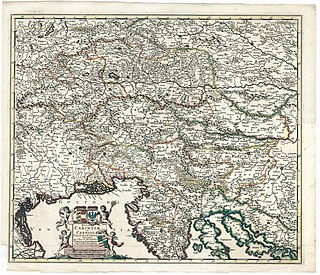
The history of Slovenia chronicles the period of the Slovenian territory from the 5th century BC to the present. In the Early Bronze Age, Proto-Illyrian tribes settled an area stretching from present-day Albania to the city of Trieste. The Slovenian territory was part of the Roman Empire, and it was devastated by the Migration Period's incursions during late Antiquity and the Early Middle Ages. The main route from the Pannonian plain to Italy ran through present-day Slovenia. Alpine Slavs, ancestors of modern-day Slovenians, settled the area in the late 6th Century AD. The Holy Roman Empire controlled the land for nearly 1,000 years, and between the mid-14th century and 1918 most of Slovenia was under Habsburg rule. In 1918, most Slovene territory became part of the Kingdom of Serbs, Croats, and Slovenes, and in 1929 the Drava Banovina was created within the Kingdom of Yugoslavia with its capital in Ljubljana, corresponding to Slovenian-majority territories within the state. The Socialist Republic of Slovenia was created in 1945 as part of federal Yugoslavia. Slovenia gained its independence from Yugoslavia in June 1991, and today it is a member of the European Union and NATO.
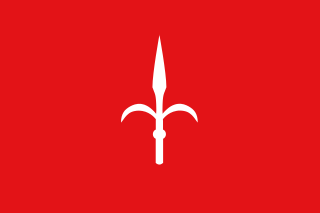
The Free Territory of Trieste was an independent territory in Southern Europe between northern Italy and Yugoslavia, facing the north part of the Adriatic Sea, under direct responsibility of the United Nations Security Council in the aftermath of World War II. For a period of seven years, it acted as a free city.
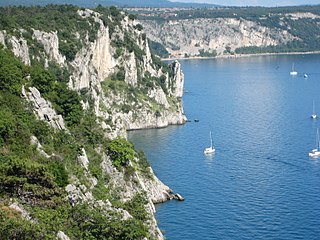
The Karst Plateau or the Karst region, also locally called Karst, is a karst plateau region extending across the border of southwestern Slovenia and northeastern Italy.

The province of Trieste was a province in the autonomous Friuli-Venezia Giulia region of Italy. Its capital was the city of Trieste. It had an area of 212 square kilometres (82 sq mi) and it had a total population of 234,668. It had a coastal length of 48.1 kilometres (29.9 mi). Abolished in 2017, it was reestablished in 2019 as the regional decentralization entity of Trieste, and was reactivated on 1 July 2020.

Duino is today a seaside resort on the northern Adriatic coast. It is a hamlet of Duino-Aurisina, a municipality (comune) of the Friuli–Venezia Giulia region of northeastern Italy. The settlement, picturesquely situated on the steep Karst cliffs of the Gulf of Trieste, is known for Duino Castle, immortalized by the poet Rainer Maria Rilke in his Duino Elegies.

General elections were held in Italy on 18 April 1948 to elect the first Parliament of the Italian Republic.

The Princely County of Gorizia and Gradisca, historically sometimes shortened to and spelled "Goritz", was a crown land of the Habsburg dynasty within the Austrian Littoral on the Adriatic Sea, in what is now a multilingual border area of Italy and Slovenia. It was named for its two major urban centers, Gorizia and Gradisca d'Isonzo.
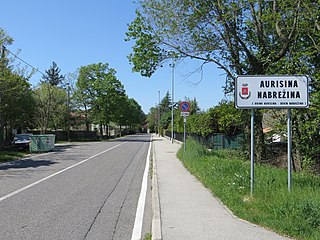
Aurisina is a town in the karst part of the comune of Duino-Aurisina near Trieste, Italy, in a region of Slovene minority. It lies 15 kilometres northwest of Trieste, and according to the 2003 census had a total of 2,406 inhabitants, 60% of them Slovenes.

The Morgan Line was the line of demarcation set up after World War II in the region known as Julian March which prior to the war belonged to the Kingdom of Italy. The Morgan Line was the border between two military administrations in the region: the Yugoslav on the east, and that of the Allied Military Government on the west. After 15 September 1947, the Allied Military Government was composed of both the British Element Trieste Forces (BETFOR) troops from the United Kingdom and the Trieste United States Troops (TRUST) from the United States.
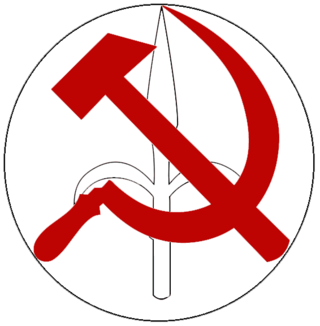
The Communist Party of the Free Territory of Trieste was a communist party in the Free Territory of Trieste. It was founded at a congress in 1945 by a merger of the local branches of the Italian Communist Party and the Communist Party of Slovenia as the Communist Party of the Julian Region. The party published a daily newspaper, Il Lavoratore.

Doberdò del Lago is a comune (municipality) in the Regional decentralization entity of Gorizia in the Italian region of Friuli Venezia Giulia, located about 30 kilometres (19 mi) northwest of Trieste and about 11 kilometres (7 mi) southwest of Gorizia, and borders the following municipalities: Duino-Aurisina, Fogliano Redipuglia, Komen (Slovenia), Miren-Kostanjevica (Slovenia), Monfalcone, Ronchi dei Legionari, Sagrado, and Savogna d'Isonzo. It is located in the westernmost part of the Karst Plateau.

Monrupino is a comune (municipality) in the Regional decentralization entity of Trieste in the Italian region of Friuli Venezia Giulia, located about 9 kilometres (5.6 mi) north of Trieste, on the border with Slovenia. As of 31 December 2004, it had a population of 848 and an area of 12.7 square kilometres (4.9 sq mi). According to the 1971 census, 77.3% of the population are Slovenes.

The Slovene Union is a political party in Italy representing the Slovene minority in the Friuli-Venezia Giulia region. Its Slovene name means literally "Slovene Community", but the denomination "Slovene Union" is used in other languages.
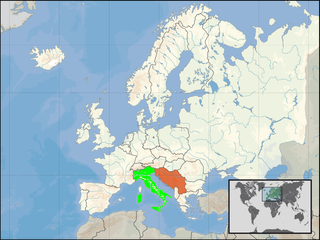
Italy–Yugoslavia relations are the cultural and political relations between Italy and Yugoslavia in the 20th century, since the creation of Yugoslavia in 1918 until its dissolution in 1992. Relations during the interwar years were hostile because of Italian irredentist demands to Yugoslav territory, leading to Fascist Italy and the Axis Powers invading Yugoslavia during World War II. After lingering tensions after the war over the status of the Free Territory of Trieste, relations improved during the Cold War.

Engelbert Besednjak was a Slovene Christian Democrat politician, lawyer and journalist. In the 1920s, he was one of the leaders of the Slovene and Croat minority in the Italian-administered Julian March. In the 1930s, he was one of the leaders of Slovene anti-Fascist émigrés from the Slovenian Littoral, together with Josip Vilfan, Ivan Marija Čok and Lavo Čermelj.
The Anti-Fascist Youth Union of the Free Territory of Trieste, initially known as the Anti-Fascist Youth Union of the Julian March was a youth movement in the Julian March. It was active between 1945 and 1954.

The Slavic-Italian Anti-Fascist Union was a political movement in the Free Territory of Trieste. It was the most important mass organization of the Communist Party of the Free Territory of Trieste (PCTLT/KPSTO). UAIS/SIAU had around 70,000 members.
Slovene minority in Italy, also known as Slovenes in Italy is the name given to Italian citizens who belong to the autochthonous Slovene ethnic and linguistic minority living in the Italian autonomous region of Friuli-Venezia Giulia. The vast majority of members of the Slovene ethnic minority live in the Provinces of Trieste, Gorizia, and Udine. Estimates of their number vary significantly; the official figures show 52,194 Slovenian speakers in Friuli-Venezia Giulia, as per the 1971 census, but Slovenian estimates speak of 83,000 to 100,000 people.
The Centrism was a political formula that inspired the Atlanticist, anti-communist, and centrist governments of the Italian Republic between the end of the 1940s and the early 1950s. The governments of this period, also known as "The Years of Centrism", were characterized by a coalition pact between the Christian Democracy (DC) and the other minor secular parties.
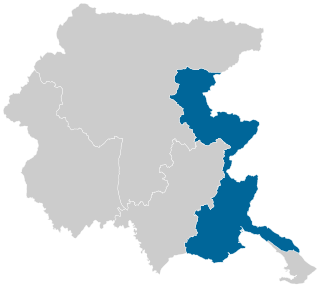
The Gorizia electoral district was an uninominal district in Italy for the Chamber of Deputies.
References
- 1 2 3 COMMUNIST PARTY OF THE FREE TERRITORY OF TRIESTE SUCCEEDS AT THE MUNICIPAL ELECTIONS . Current Digest of the Post-Soviet Press, No. 25, Vol.1, July 19, 1949, p. 34
- 1 2 3 4 5 6 7 8 9 Zucca, Lorenzo. LA CITTÀ OCCUPATA (1948 – 1951) [ permanent dead link ]
- 1 2 3 Sluga, Glenda. The Problem of Trieste and the Italo-Yugoslav Border: Difference, Identity, and Sovereignty in Twentieth Century Europe . Albany: State Univ. of New York Press, 2001. p. 150
- ↑ Puppini, Marco. Il quadro politico dopo il trattato di pace del 1947 e la risoluzione del Cominform del 1948 Archived 2011-07-16 at the Wayback Machine . Consorzio Culturale del Monfalconese